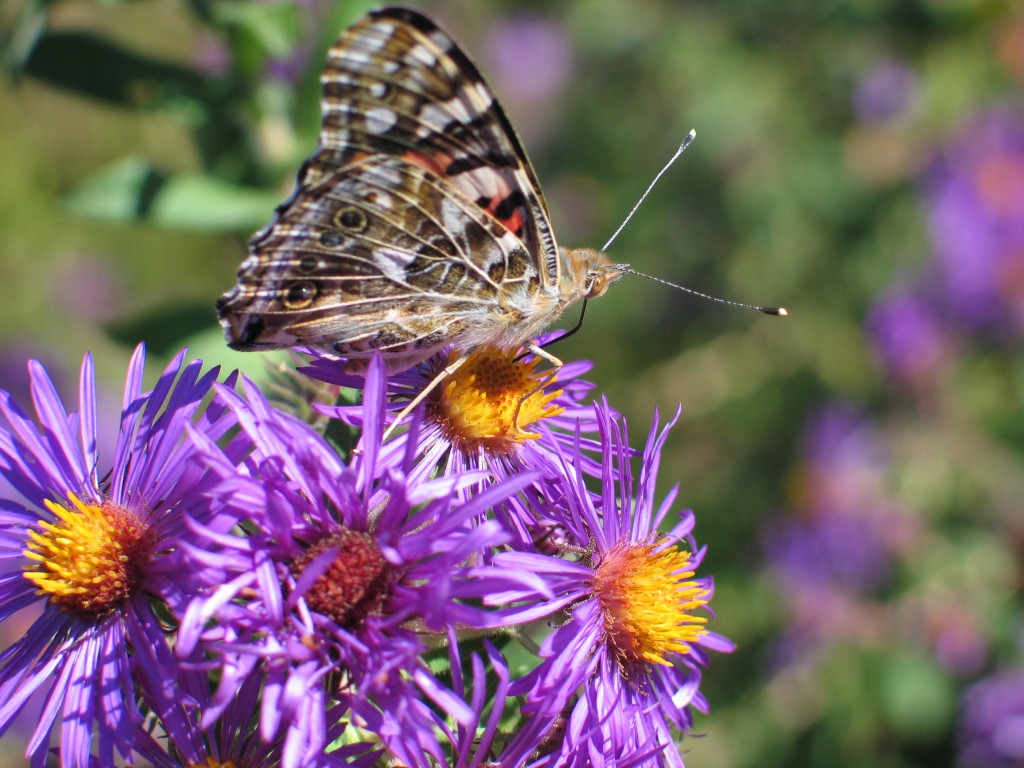
Butterfly Garden Necessities
Plant native flowering plants.
Because many butterflies and native flowering plants have co-evolved over time and depend on each other for survival and reproduction, it is particularly important to install native flowering plants local to your geographic area. Native plants provide butterflies with the nectar or foliage they need as adults and caterpillars.
Plant type and color is important.
Adult butterflies are attracted to red, yellow, orange, pink and purple blossoms that are flat-topped or clustered and have short flower tubes.
Plant good nectar sources in the sun.
Your key butterfly nectar source plants should receive full sun from mid-morning to mid-afternoon. Butterfly adults generally feed only in the sun. If sun is limited in your landscape, try adding butterfly nectar sources to the vegetable garden.
Plant for continuous bloom.
Butterflies need nectar throughout the adult phase of their life span. Try to plant so that when one plant stops blooming, another begins.
Say no to insecticides.
Insecticides are marketed to kill insects. Don’t use these materials in or near the butterfly garden or better, anywhere on your property.
Feed butterfly caterpillars.
If you don’t “grow” caterpillars, there will be no adults. Bringing caterpillar foods into your garden can greatly increase your chances of attracting unusual and uncommon butterflies, while giving you yet another reason to plant an increasing variety of native plants. In many cases, caterpillars of a species feed on only a very limited variety of plants. Most butterfly caterpillars never cause the leaf damage we associate with some moth caterpillars such as bagworms, tent caterpillars, or gypsy moths.
Provide a place for butterflies to rest.
Butterflies need sun for orientation and to warm their wings for flight. Place flat stones in your garden to provide space for butterflies to rest and bask in the sun.
Give them a place for puddling.
Butterflies often congregate on wet sand and mud to partake in “puddling,” drinking water and extracting minerals from damp puddles. Place coarse sand in a shallow pan and then insert the pan in the soil of your habitat. Make sure to keep the sand moist.
Butterfly Type: Caterpillar Food / Host Plant
Alfalfa butterfly: Alfalfa, clovers, deerweed
Anise Swallowtail: Sweet Fennel, Lomatium, Citrus
Black swallowtail: Dill, parsley, fennel, carrot
Buckeye: plantains, gerardias, toadflax, snapdragons, false loosestrifes
Cabbage White: Many plants in mustard family, cabbage family
Checkered skipper: Mallow, hollyhock
Checkered white: Tumble mustard
Clouded sulfur: Alfalfa, clover
Cloudless Sulfur: Ornamental Cassia, Canary Bird Bush
Common hairstreak: mallow family , hollyhock , rose and marsh mallows
Common Snout Butterfly: Hackberry
Dogface Butterfly: lead plant, false indigo, prairie clover
Eastern Tiger Swallowtail: sycamore, willow
Edwards fritillary: Nuttall’s violet
Cabbage White: Broccoli, cabbage (mustard family)
Gorgone checkerspot: Sunflowers
Hackberry butterfly: Hackberry
Melissa blue: Wild licorice, alfalfa, etc.
Monarch: Milkweed
Mourning cloak: Willow, aspen, cottonwood, elm
Orange sulfur: Alfalfa, vetch, pea
Painted Lady: Thistle, hollyhock, sunflower
Pale Swallowtail: Redberry, California Coffeeberry, California Lilac, Holly-leafed Cherry
Question Mark: nettle, elm, hackberry, hops, false nettles
Red Admiral: nettle, false nettle, pellitory
Red-Spotted Purple: Wild cherry, oak, poplar, hawthorn, willow
Silver-spotted skipper: Wild licorice, locust, etc.
Spicebush Swallowtail: spice bush, sassafrass
Two-tailed swallowtail: Green ash, chokecherry
Variegated fritillary: Various, including pansy
Viceroy Butterfly: willow, poplar, apple
Weidemeyer’s admiral: Willow, aspen, cottonwood
Western tiger swallowtail: Willow, cottonwood, chokecherry
Wood nymph: Grasses
Zebra Swallowtail: Pawpaw
